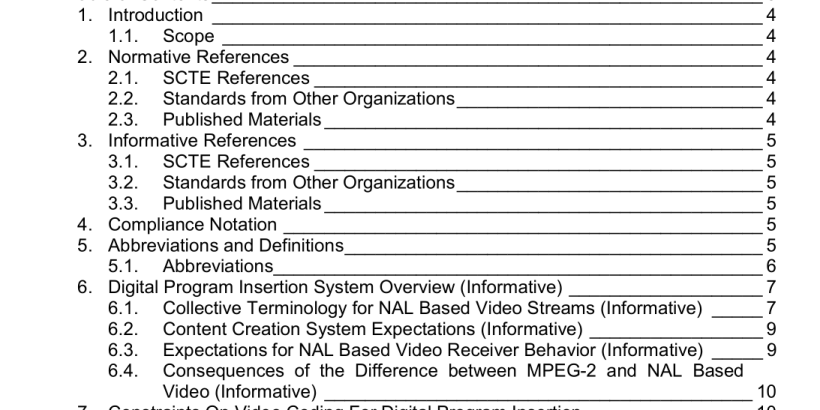ANSI SCTE 172-2017 pdf download.Constraints On AVC and HEVC Structured Video Coding for Digital Program Insertion
1.1. Scope
This document defines additional video coding and transport constraints on ANSI/SCTE 128 [2][3] (which constrains ITU-T H.264/ ISO/IEC 14496-10 (“AVC”) video compression [7]) or on ANSI/SCTE 215 [4][5] (which constrains ITU-T H.265/ISO/IEC 23008-2 (“HEVC”) video compression [9]) for Digital Program Insertion applications using SCTE 35 messaging [1]. AVC and HEVC video uses a network abstraction layer structure to carry video and in this document “NAL structured video” will collectively refer to both AVC and HEVC Video. Note: This standard applies only when both the insertion content and the network both use AVC video coding or both use HEVC video coding.
2. Normative References
The following documents contain provisions, which, through reference in this text, constitute provisions of this document. At the time of Subcommittee approval, the editions indicated were valid. All documents are subject to revision; and while parties to any agreement based on this document are encouraged to investigate the possibility of applying the most recent editions of the documents listed below, they are reminded that newer editions of those documents might not be compatible with the referenced version.
4. Compliance Notation
This word or the adjective“required’ means that the item is an absolute requirement of this document. This phrase means that the item is an absolute prohibition of this document. This word means the value specified shall never be used. This word or the adjective“recommended’ means that there may exist valid reasons in particular circumstances to ignore this item, but the full implications should be understood and the case carefully weighted before choosing a different course. This phrase means that there may exist valid reasons in particular circumstances when the listed behavior is acceptable or even useful, but the full implications should be understood and the case carefully weighed before implementing any behavior described with this label. This word or the adjective“optional?’ means that this item is truly optional. One vendor may choose to include the item because a particular marketplace requires it or because it enhances the product, for example; another vendor may omit the same item. Use is permissible for legacy purposes only. Deprecated features may be removed from future versions of this document. Implementations should avoid use of deprecated features.
6. Digital Program Insertion System Overview (Informative)
Digital Program Insertion assumes a linear program delivery with periodic insertion opportunities signaled by ANSI/SCTE 35 [1]splice_info_section( ) messages carried in TS packets of a particular PID or PIDs within the program’s TS. Insertion opportunities signal first a splice from network PTS value (usually to an advertisement) and optionally followed some time later by the signaling of a splice back into a different (usually later) network PTS value. An alternative signaling method signals only the first PTS but supplies a duration and signals “auto return to network.” Signaling may also, in the case of content which may be delivered in a non-time-linear method (e.g. VoD), specify that the return to network PTS value be the same as the initial PTS value. Insertion durations are seconds in length normally, although they are sometimes hours in length. For typical commercials durations run 30, 60, or 120 seconds. Different delivery mechanisms may use different technologies to perform the insertions. For example, insertions in linear program delivery are typically done by a splicer/content server pair. In a VOD environment a VOD server may assemple a playlist of entertainment content and the inserted ads. For DASH delivery ad content segments may be inserted into or replaced in the manifest. The coding constraints defined in the specification are applicable to all delivery mechanisms. The transport constraints are applicable to delivery mechanisms that are based on MPEG transport [6].ANSI SCTE 172-2017 pdf download
